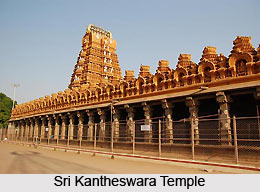 Amongst the many temple towns in Karnataka Nanjangud is widely popular. Situated on the banks of river Kapila it is blessed with an amazing landscape. Like many temple towns in Karnataka this place has temples dedicated to Lord Shiva. Another name of the lord is Nanjangudeshwara. This name literally means the god who drank poison. There is an interesting tale associated with it. According to the legend both the asuras (demons) and the devtas (gods) churned the ocean of existence to get hold of the nectar. Whoever had this would be immortal. During this churning a lot of poison stemmed out of the ocean. To save the creation from being destroyed by the venom Lord Shiva drank the poison.
Amongst the many temple towns in Karnataka Nanjangud is widely popular. Situated on the banks of river Kapila it is blessed with an amazing landscape. Like many temple towns in Karnataka this place has temples dedicated to Lord Shiva. Another name of the lord is Nanjangudeshwara. This name literally means the god who drank poison. There is an interesting tale associated with it. According to the legend both the asuras (demons) and the devtas (gods) churned the ocean of existence to get hold of the nectar. Whoever had this would be immortal. During this churning a lot of poison stemmed out of the ocean. To save the creation from being destroyed by the venom Lord Shiva drank the poison.
The place is named after the lord. Nanjangud refers to the place where Nanjangudeshwara dwells. This place in Karnataka is a popular destination for Shaivites and it has been so for ages. The Nanjundeshwara temple is the main attraction here. It is believed to have been built in the Ganga period. Nanjundeshwara temple was later renovated by the Hoysala rulers. Hyder Ali and Tipu Sultan, too, were closely associated with the temple. Apart from this, the temple also received several grants from the Wodeyar dynasty for revamping it.
Nanjangud is a town in Mysore district in the Indian state of Karnataka. It is a temple town and is on the banks of the river Kapila. It is at a distance of 23 km from the city of Mysore. Nanjangud is also called as "Dakshina Kashi"
The huge temple is also known as Srikanteswara. According to legends Lord Buddha had stayed here and consecrated the Shiva linga. According to the inscriptions available in the temple Tipu Sultan`s favorite elephanted was granted eyesight at this temple. To show his gratitude the king remade the linga in jade and donated it to Nanjundeshwara temple. Till date this holy place is considered as a healer for its followers. The ritual of bathing in the Kapila River is prevalent even today.
Nanjangud in Karnataka is also famous for the various festivals that take place here. The Chariot festival takes place twice a year and this is commonly known as Dodda Jathre and the Chikka Jathre. Five separate chariots Lord Ganapathi, for Lord Srikanteshwara, Lord Subramanya and Goddess Parvathi, Lord Chandikeshwara are taken out with huge procession. Besides this there is also a Sri Raghavendra Swamy Mutt.





















